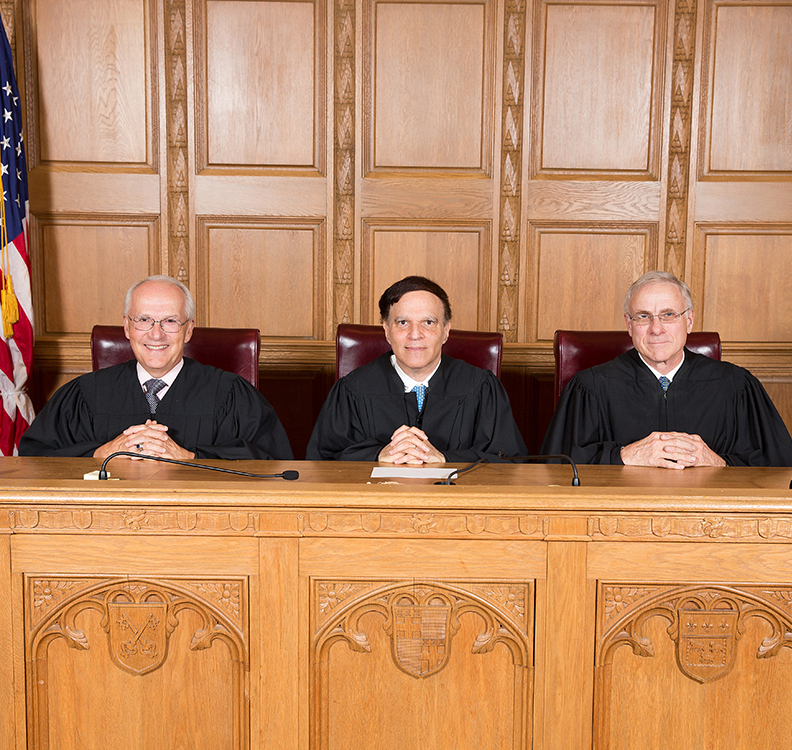This website uses cookies
We use cookies to ensure that we give you the best experience on our website. If you continue to use this site we will assume that you are happy with it.

On September 21, the U.S. Court of Appeals for the Second Circuit — Chief Judge Robert A. Katzmann, Judge Peter W. Hall ’77, and Judge Richard C. Wesley ’74 — brought a full docket to the MacDonald Moot Court Room at Cornell Law School. With ten minutes for each side, attorneys argued a range of issues from due process and possession of child pornography to the limits of solitary confinement, the sixth amendment, and the Fair Labor and Standards Act.
“The courts play an important educational role, and as students watch these proceedings, we hope they see oral arguments as a living example of what they’re learning in law school,” said Judge Katzmann, who has taught at NYU and UCLA, and whose Judging Statutes (Oxford 2014) was described as “required reading for all lawyers” by U.S. Supreme Court Justice John Paul Stevens. “In class, they learn about advocacy, they learn about writing briefs, they learn about the lawyering process. In the courtroom, they see all those pieces coming together in real cases with real lawyers and real judges. Today is a terrific example of what courts should be doing, and we hope students will ask themselves, ‘What makes a good brief? What makes a good oral argument?’”
For people attending the hearings and the Q&A that followed, there were important lessons about how to argue a weak case, how to address the bench, and how to answer a question you don’t want to answer. (Honestly. Quickly.) To David Russell ’17, who hadn’t seen the Second Circuit in action, it was surprising to see how effectively a case could be argued in only ten minutes; to Nicholas Jacques ’17, who’s going to judge an upcoming round of a student moot court competition, it was impressive to watch the bench taking such an active role in questioning each of the attorneys arguing before them.
“We had an interesting smattering of cases, with enough variety to give some indication of a typical day for our court,” said Judge Hall, talking at the lunch that followed the morning’s five appellate arguments. “We want students to get a taste of what we do, observing first-hand how the court operates in hearing oral arguments. It’s an opportunity to see what a hot bench looks like. As a panel, we invariably treat counsel for the petitioners with respect. We’re prepared to probe the issues within the timeframe allowed, but if we’re engaged in a conversation on a particular question, we continue to discuss it with counsel until we’re satisfied.”
Following arguments, the judges will discuss which cases will be decided by summary order and which by opinion. They will then divide the opinions and take their cases back to chambers, where they’ll confer with their law clerks and begin the process of drafting and redrafting their decisions. After a week of hearing thirty-five cases, Judges Hall, Katzmann, and Wesley will emerge with three or four opinions apiece, which they’ll circulate to one another over the next month. (“It’s great work,” says Judge Hall, “if you like to write and think.”) Along with hearing the argued cases, they’ll consider and decide another twenty or thirty motions. The following week, they’ll begin to prepare for the next set of cases scheduled for arguments some four to six weeks in the future.
“It was a good day and a good learning opportunity,” said Judge Wesley, who co-teaches Cornell Law’s Federal Appellate Practice class with Professor John H. Blume, which culminates in oral arguments before the Second Circuit in New York City. “Students are always interested in knowing how and why judges react, what does and doesn’t work. Because the reality is that the vast majority of lawyers never get to see behind the veil. That makes these hearings a really valuable experience, and for me, coming back to Cornell always feels like home. My law career has been nothing but joy for me, and it all started here.”